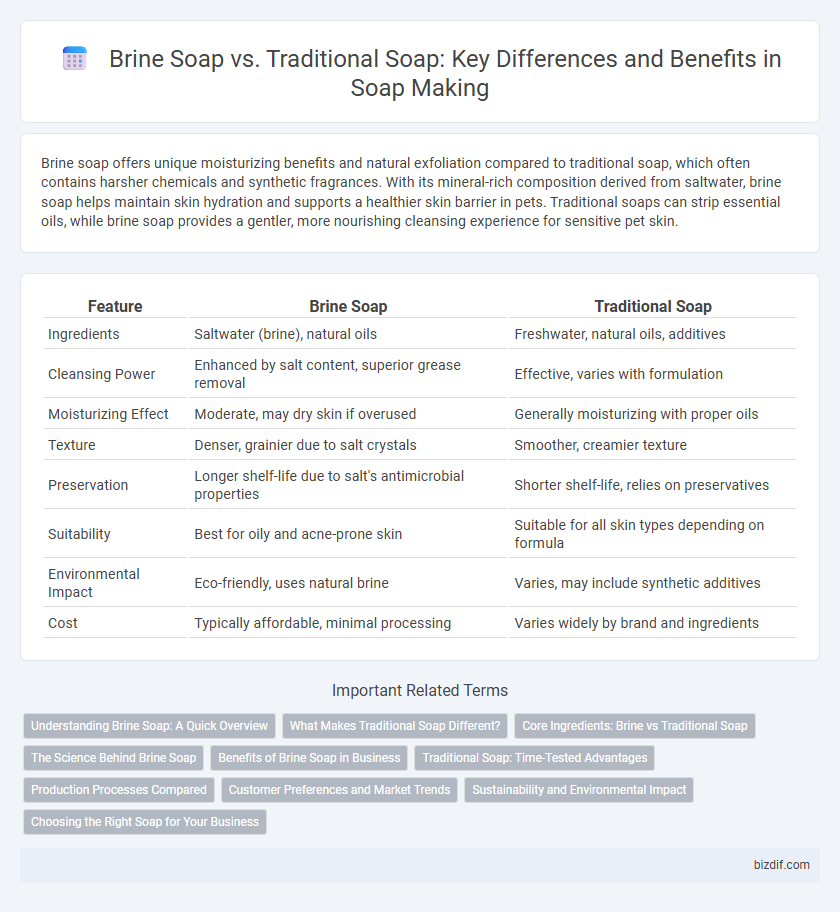Brine soap offers unique moisturizing benefits and natural exfoliation compared to traditional soap, which often contains harsher chemicals and synthetic fragrances. With its mineral-rich composition derived from saltwater, brine soap helps maintain skin hydration and supports a healthier skin barrier in pets. Traditional soaps can strip essential oils, while brine soap provides a gentler, more nourishing cleansing experience for sensitive pet skin.
Table of Comparison
| Feature | Brine Soap | Traditional Soap |
|---|---|---|
| Ingredients | Saltwater (brine), natural oils | Freshwater, natural oils, additives |
| Cleansing Power | Enhanced by salt content, superior grease removal | Effective, varies with formulation |
| Moisturizing Effect | Moderate, may dry skin if overused | Generally moisturizing with proper oils |
| Texture | Denser, grainier due to salt crystals | Smoother, creamier texture |
| Preservation | Longer shelf-life due to salt's antimicrobial properties | Shorter shelf-life, relies on preservatives |
| Suitability | Best for oily and acne-prone skin | Suitable for all skin types depending on formula |
| Environmental Impact | Eco-friendly, uses natural brine | Varies, may include synthetic additives |
| Cost | Typically affordable, minimal processing | Varies widely by brand and ingredients |
Understanding Brine Soap: A Quick Overview
Brine soap is made using a saturated saltwater solution during the saponification process, resulting in a harder bar with increased longevity and unique cleansing properties. Unlike traditional soap, which typically uses freshwater, brine soap offers enhanced exfoliation and a distinct mineral-rich composition that can improve skin texture. Its salt content also provides natural antibacterial benefits, making it an effective option for thorough skin cleansing.
What Makes Traditional Soap Different?
Traditional soap differs from brine soap primarily in its production process and ingredients, using natural fats or oils saponified with an alkali like lye, resulting in a gentle, moisturizing bar. It typically lacks the high salt content found in brine soap, which contains dissolved salt that can create a firmer texture but may be harsher on the skin. Traditional soap often emphasizes natural additives and essential oils, catering to those seeking a more skin-friendly, environmentally conscious cleansing option.
Core Ingredients: Brine vs Traditional Soap
Brine soap incorporates concentrated saltwater brine, which enhances cleansing properties and creates a natural exfoliating effect, while traditional soap relies on a combination of fats or oils and lye (sodium hydroxide or potassium hydroxide) for saponification. The high salt content in brine soap helps to produce a harder, longer-lasting bar with increased antimicrobial benefits compared to the softer texture of traditional soap. Traditional soap's core ingredients vary widely, including vegetable oils like olive or coconut oil, which influence the soap's moisturizing qualities and lather production.
The Science Behind Brine Soap
Brine soap harnesses the natural cleansing power of saltwater, utilizing salt's antimicrobial properties to enhance the soap's ability to break down oils and bacteria on the skin. Unlike traditional soap, which relies primarily on saponified fats and oils for cleansing, brine soap incorporates saline solutions that alter the soap's pH and ionic strength, improving lather quality and skin exfoliation. This scientific foundation explains why brine soap often delivers superior skin hydration and prevents microbial growth more effectively than conventional soap formulations.
Benefits of Brine Soap in Business
Brine soap offers unique benefits in business by providing enhanced natural mineral content that improves skin hydration and antimicrobial properties, distinguishing products in competitive markets. Its eco-friendly production appeals to environmentally conscious consumers, supporting sustainable brand positioning and potentially increasing market share. The longer shelf life and reduced need for preservatives also lower costs and simplify inventory management for manufacturers.
Traditional Soap: Time-Tested Advantages
Traditional soap offers time-tested advantages rooted in natural ingredients and artisanal craftsmanship, providing gentle cleansing and moisturizing properties ideal for sensitive skin. Its production involves a slow saponification process that preserves glycerin, enhancing skin hydration and nourishment. Many users prefer traditional soap for its eco-friendly, biodegradable composition that reduces environmental impact compared to synthetic alternatives.
Production Processes Compared
Brine soap production involves incorporating saltwater or brine into the saponification process, which accelerates curing and creates a harder, longer-lasting bar compared to traditional soap that uses fresh water. Traditional soap production relies on natural oils and lye with extended curing times, resulting in a softer texture and slower hardening. The inclusion of brine alters the chemical balance during saponification, enhancing durability and reducing moisture retention in the final product.
Customer Preferences and Market Trends
Brine soap offers a unique mineral-rich composition that appeals to customers seeking natural exfoliation and skin hydration, distinguishing it from traditional soap's simpler formulas. Market trends indicate a growing demand for artisanal and specialty soaps, with brine soap gaining traction in health-conscious and eco-friendly segments. Consumer preferences are shifting towards products featuring sustainable sourcing and multifunctional benefits, making brine soap a standout choice in competitive soap markets.
Sustainability and Environmental Impact
Brine soap utilizes saline water from salt brines, reducing freshwater consumption and minimizing waste in the soap production process. Traditional soap often relies on higher quantities of fresh water and can involve ingredients sourced from environmentally intensive agriculture. Brine soap's use of recycled saline byproducts supports circular economy practices and lowers the overall environmental footprint compared to conventional soap production.
Choosing the Right Soap for Your Business
Brine soap, enriched with mineral salts, offers enhanced antimicrobial properties and a unique texture compared to traditional soap made from natural fats and lye. Businesses aiming for niche markets like skincare or spa services benefit from brine soap's premium appeal and skin-soothing qualities, while traditional soap is cost-effective and versatile for general cleansing needs. Assessing target customer preferences and production costs helps determine the optimal soap type to maximize profitability and brand differentiation.
Brine Soap vs Traditional Soap Infographic

 bizdif.com
bizdif.com